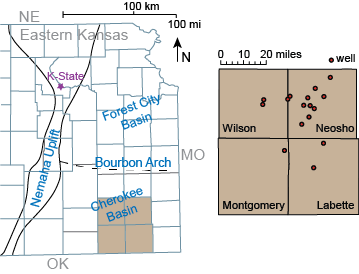Reports: UNI253188-UNI2: Field Study of Fundamental Controls on Methane Formation in a Coalbed Methane Reservoir
Matthew F. Kirk, PhD, Kansas State University
Over the past year, our research group continued working to understand the two-way interactions between geochemistry and microbiology in coalbed methane reservoirs in the Cherokee Basin, Kansas, USA. This past year was the third year of our project. Our efforts during project year 1 included sample collection (Fig. 1), laboratory geochemical and microbiological characterizations, and data analysis.
Figure 1. Location of 15 commercial coalbed methane wells we sampled for the study. At each well, we measured the pH, temperature, and electrical conductivity of water samples and we collected samples of water, gas, and microbes for laboratory analysis.
During year 2, we worked to integrate the results of our geochemical and microbiological analyses and prepare a MS thesis, an undergraduate thesis, and a manuscript. During year 3, we revised our manuscript, which was then accepted for publication in the journal Frontiers in Microbiology (Kirk et al., 2015, v. 6, article 1287). In addition, undergraduate students involved in the work carried out a series of cultivation experiments based on our initial study. More details about our efforts during year 3 follow below:
1. High-impact publication
Our manuscript shows that methane in Cherokee Basin coalbeds was formed primarily by hydrogenotrophic methanogens, microorganisms that make methane by eating hydrogen. However, the proportion of methane formed by acetoclastic methanogens, microbes that make methane by eating acetate, increases with the solute content of the water (See Table of Contents figure). This trend is unexpected because it is contrary to existing conceptual models for microbial methanogenesis. It is significant because it helps us understand salinity constraints on methanogenic processes and how commercial gas production activities could influence natural gas formation. Early indicators suggest our article will have a significant impact. For example, it was the fifth most viewed article the journal published that month. Since the article was published in mid-November of 2015, it has already been viewed over 2,000 times.
2. Laboratory experiments
During year 3, we tested the influence of several environmental variables on the rate of methane formation from coal and crude oil in laboratory cultures. The effort was led by undergraduate students with mentoring from me and a postdoc in the lab group. Variables tested included ammonium and phosphate concentration, organic carbon amendment, and pH. Unfortunately, they did not identify any amendment that could significantly stimulate methane generation, suggesting that other aspects of the system are rate-limiting. Nonetheless, the experiment provided a valuable opportunity for the students to gain experience with laboratory methods and applying the scientific process
3. Professional development
I have used my award to fund my first graduate and undergraduate students, established a relationship with an energy industry partner, and collect a dataset that will provide a strong foundation for future energy research. The students involved have gained broad experience, which they have both successfully leveraged to get to the next steps in their career. The graduate student is now gainfully employed at a major energy company. The first undergraduate student involved in the work was successful in his application for an assistantship in graduate school. During the past year students have also gained experience presenting their findings at two conferences.












